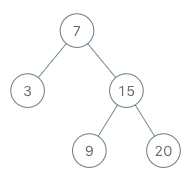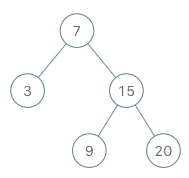实现一个二叉搜索树迭代器。你将使用二叉搜索树的根节点初始化迭代器。
调用 next() 将返回二叉搜索树中的下一个最小的数。
示例:


BSTIterator iterator = new BSTIterator(root); iterator.next(); // 返回 3 iterator.next(); // 返回 7 iterator.hasNext(); // 返回 true iterator.next(); // 返回 9 iterator.hasNext(); // 返回 true iterator.next(); // 返回 15 iterator.hasNext(); // 返回 true iterator.next(); // 返回 20 iterator.hasNext(); // 返回 false
提示:
next()和hasNext()操作的时间复杂度是 O(1),并使用 O(h) 内存,其中 h 是树的高度。- 你可以假设
next()调用总是有效的,也就是说,当调用next()时,BST 中至少存在一个下一个最小的数。
# Definition for a binary tree node. # class TreeNode: # def __init__(self, x): # self.val = x # self.left = None # self.right = None class BSTIterator: def preorderTraversal(self, root): if not root:return [] stack, res = [root], [] while stack: root = stack.pop() if root: res.append(root.val) if root.right: stack.append(root.right) if root.left: stack.append(root.left) return res def __init__(self, root: TreeNode): self.nodes=sorted(self.preorderTraversal(root)) def next(self) -> int: """ @return the next smallest number """ if self.hasNext(): return self.nodes.pop(0) else: return None def hasNext(self) -> bool: """ @return whether we have a next smallest number """ return len(self.nodes)>0 # Your BSTIterator object will be instantiated and called as such: # obj = BSTIterator(root) # param_1 = obj.next() # param_2 = obj.hasNext()
# Definition for a binary tree node. # class TreeNode: # def __init__(self, val=0, left=None, right=None): # self.val = val # self.left = left # self.right = right class BSTIterator: def __init__(self, root: TreeNode): self.stack = [] while root: self.stack.append(root) root = root.left def next(self) -> int: """ @return the next smallest number """ node = self.stack.pop() r = node.right while r: self.stack.append(r) r = r.left return node.val def hasNext(self) -> bool: """ @return whether we have a next smallest number """ return len(self.stack) > 0 # Your BSTIterator object will be instantiated and called as such: # obj = BSTIterator(root) # param_1 = obj.next() # param_2 = obj.hasNext()